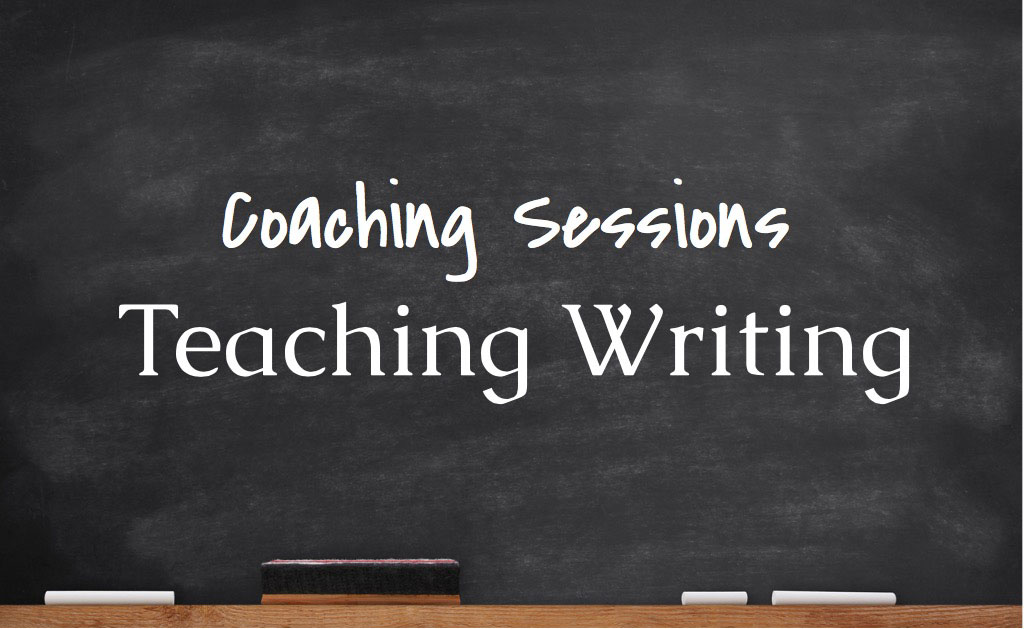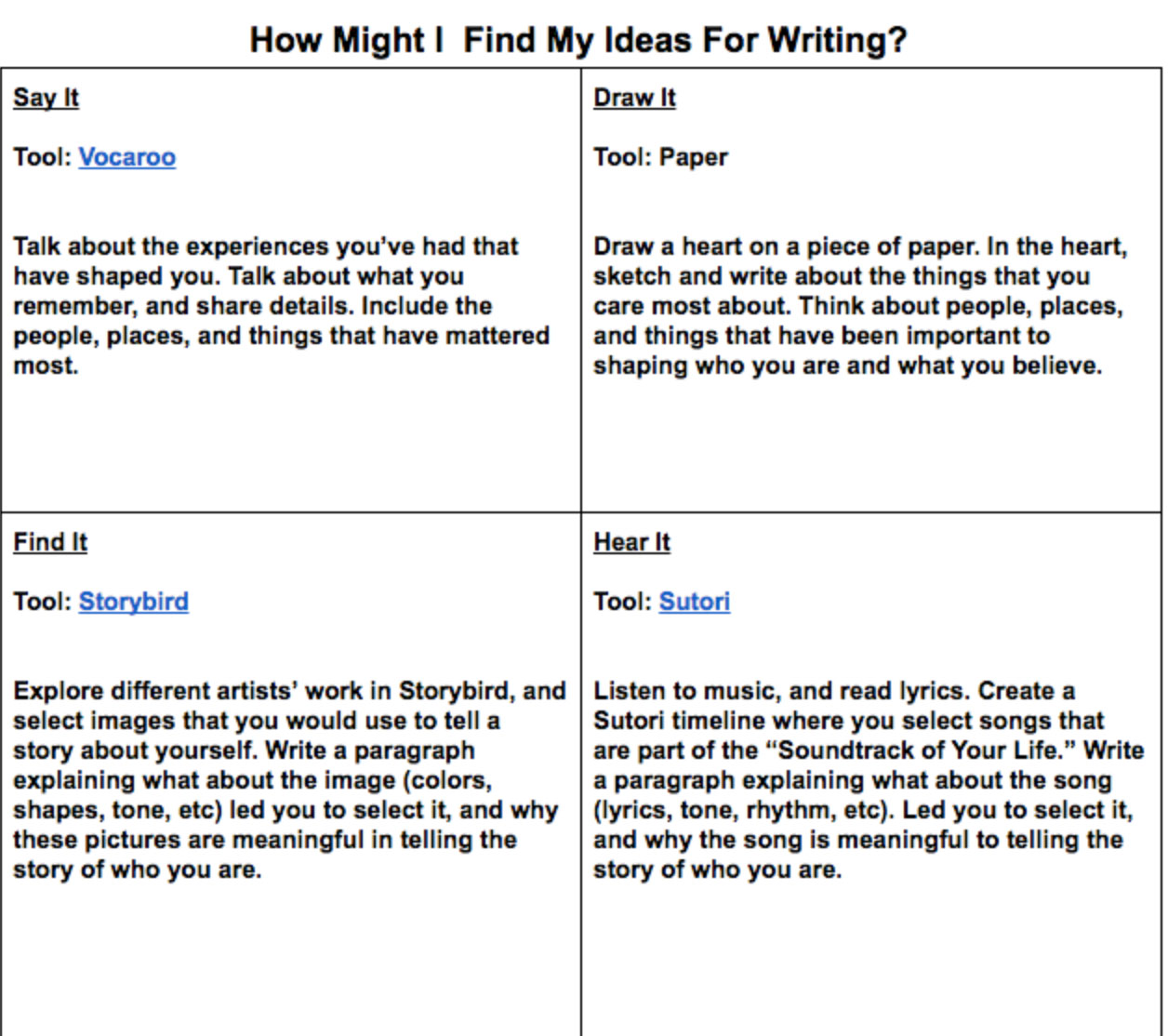In her first Coaching Sessions blog post, Julie, TeacherVision's Head of Content and Curriculum, and a former instructional coach, shares her learnings and strategies for how to help students find and develop their writing voice.

“I’m not a writer,” she tells me.
“That’s why I’m here for Writing Lab.”
This is a five-year-old memory, but I can still recall the first time this student came to work with me after school on her writing. She was in my 7th grade English class.
Energetic and gregarious, she was the student who waved her hand in air and demanded to be heard. Other teachers were often exhausted by her constant chatter, but not me.
"She had found her voice, a rare gift for a twelve-year-old girl, and she reminded me of my younger self: bossy and bold."
“Who says you aren’t a writer?” I asked.
She shared a story about her second grade teacher. The teacher who told her she wasn’t good at writing, writing wasn’t her thing.
I’d heard this story before, just a different version.
I felt the dull ache of my own memory. For me that teacher was a college professor who told me that my honors thesis wasn’t good enough to finish. I wasn’t a writer.
Even now as an adult, I am still shocked and a little bit horrified that a professor I barely knew wrote my story of who I was (or wasn’t) as a writer. I’m still tiptoeing around my writing identity.
“I write,” I tell people, but I never say, “I am a writer.”
Sometimes I replay the moment he told me, “no,” and I rewrite the story. I finish the thesis anyways. I write it my way for me. Even if no one reads it or publishes it, I put the words down.
At the time, my younger self was too ashamed to do this. She thought, no means, no, and left it at that. However, I know better now.
In The Gifts of Imperfection, social researcher, Brene Brown talks about the difference between guilt and shame. Guilt, she writes, is thinking, I did something bad. Shame, she writes, is thinking, I am bad.
"I believe that children’s identities and sense of self-worth are shaped and impacted by the people around them. As teachers, parents, coaches–human beings, we have the responsibility to help our children see the difference between their actions and their worth."
In the classroom, a teacher can, with or without intention, say something to a student that makes that student think, I am bad or, I am wrong, instead of, I said something unkind or I got the wrong answer.
Carrying around feelings of shame can lead to low self-esteem, defensiveness, and anxiety.
Shame is a heart-shaped fist.
When my professor told me I wasn’t a writer, that’s not what I heard. I heard, “you aren’t good enough,” and “you can’t do this." His feedback was no longer about the writing, it was about me, and I have carried it with me since.
Rewriting the Story
I want to rewrite the story for my student. I want to help her separate what her teacher said from who she is. Words are just words. Really they don’t mean anything. We assign meaning to them, and there is power in that. We can rewrite our stories.
"One of the reasons I became a teacher was because of that college professor. I wasn’t going to be the teacher who told students they weren’t writers and that they weren’t good at writing. I was going to show my students how to find their voices, and teach them how to develop themselves as writers."
When I shared my beliefs on writing, and told my student that she was a writer, she was hesitant. She had so many ideas, but she wasn’t sure how to say them.
She tried to outline, but then couldn’t make sense of her notes. She wrote too much, and her grades were low.
“You aren’t a good writer or a bad writer,” I told her. “We just have to find out how you write. I want you to throw out anything you’ve ever been told about how you are supposed to write, and just talk to me instead.”
So we talked. We drew pictures. We listened to music. We looked at art. We read. Itt was through our work that we came to realize that she felt best about her writing when she drew first. So instead of writing an outline, she started drawing pictures and making storyboards. Her ideas no longer felt muddled and out-of-order. They made sense to her this way.
"She had a process that felt authentic and meaningful to her that was personal. She had found her writing voice."
I didn’t have writing teachers who helped me see that there are many different ways to write and be a writer. I did have teachers who helped me find my writing voice (Thanks, Mrs. Solar).
Below you will see a choice board that you can use with your students to provide different learning pathways for finding ideas for writing. Using this can help you provide them with concrete strategies for getting started. I recommend different apps and resources, but you can modify this so it best fits your teaching style.
What is important is that students explore speaking, drawing, visualizing, and listening in order to find their writing voices.

Finding Your Writer's Voice Teaching Strategy
- Students select how they want to begin: talk, draw, listen or look.
- From there, they might get started. Or, they may use a tool like Storybird in order to browse images for inspiration and ideas.
- They will all complete the same writing task: write about the people, places, and things that are most important to you, but they will do that using different modes and different tools.
- The most important part of this strategy, I feel, is the debrief. After students are done, ask them to share what their experience was like.
- Did looking at images help them develop ideas for writing?
- How did drawing help them remember what they care about most?
- What was their experience like as a writer?
By supporting students to write about themselves, and the people, places, and things that matter to them, I believe that you are sending students a powerful message about writing: everyone is a writer, and what you want to write about and how matters.
The curriculums and systems that we teach within may require that students write for a variety of purposes and in a variety of modes, and I believe there is value in that. I also believe that we have to make difficult choices in our teaching. There is so much to cover, and often creative writing is the first unit to go.
However, if your ultimate goal is to build a community of writers and support students to find their voices, then I suggest beginning with the students’ stories, and building from there. A personal narrative unit or a sense of place unit are both recommendations I suggest to the teachers I have coached.
As you write alongside your students, you may discover stories that were told to you about who you are. Rewrite the stories if they no longer serve you, and call yourself and your students, writers.
Tips For Writing Teachers
Save Every Page
When we save students’ writing, we send a powerful message that their work is meaningful. I believe it is important to save drafts just as much as final copies. If we want to help our students see the importance and value in the writing process, then we need to show them through our actions that we value each step they took as they wrote. It can be incredibly powerful to give students the same writing prompt throughout the year, and save their responses. When you show a student what her writing looked like in November and what it looks like in January, the student is able to see her own growth. I believe this also helps build writing stamina. Writing can feel like a slow process, and it requires patience and time. If students see visible examples of their progress, they are likely to want to keep writing. Technology has increased the options for capturing the writing process. Check out Seesaw and Kidblog for two options I’d recommend.
Write Alongside Your Students
I believe that one of the best ways to discover your writer’s voice is through mentor texts. I will never forget the first time I read Sandra Cisneros’ line, “until then, I am an anchor, an anchor tied to a balloon” in A House on Mango Street. Reading her writing connected me to my own feelings. She was able to use figurative language to paint a picture with words that was a universal reflection of the human experience. I wanted to be able to do that too.
Your writing will serve as a mentor text for your students. It is also helpful for them to see you engage in the writing process. My students were always surprised when I made a grammar error or struggled to start my next paragraph. Writers are human, and mistakes are human. Therefore, writers make mistakes. Model making writing mistakes as you write alongside your students, and help them see that those mistakes are ok, and part of the process.
Call Yourself and Your Students Writers
Writing isn’t either a talent you lack or have. It is a skill that can be taught and developed over time and with practice and patience. I believe that anyone who puts the pen to paper is a writer. By calling your students writers you are validating their work, and encouraging them to make writing part of their identity.
You may feel like you don’t have time to write. If writing is something that at one point in your life brought you joy, or you want to make writing a daily practice, start by keeping a journal. Write about your teaching. Write about your family. Write about what you see, hear, and do. Put the pen to paper, and in doing so, connect with yourself.
To check out the apps I recommend for this strategy look into: Vocaroo, Storybird, and Sutori.
What are your best practices for teaching writing? Share with us on Instagram, Facebook, Twitter, and Pinterest.
Julie Mason is the Head of Curriculum and Content for TeacherVision. She taught middle and high school English for eight years, and then worked as an instructional coach, supporting K-12 teachers to blend and personalize their classrooms.
This post contains an affiliate link










